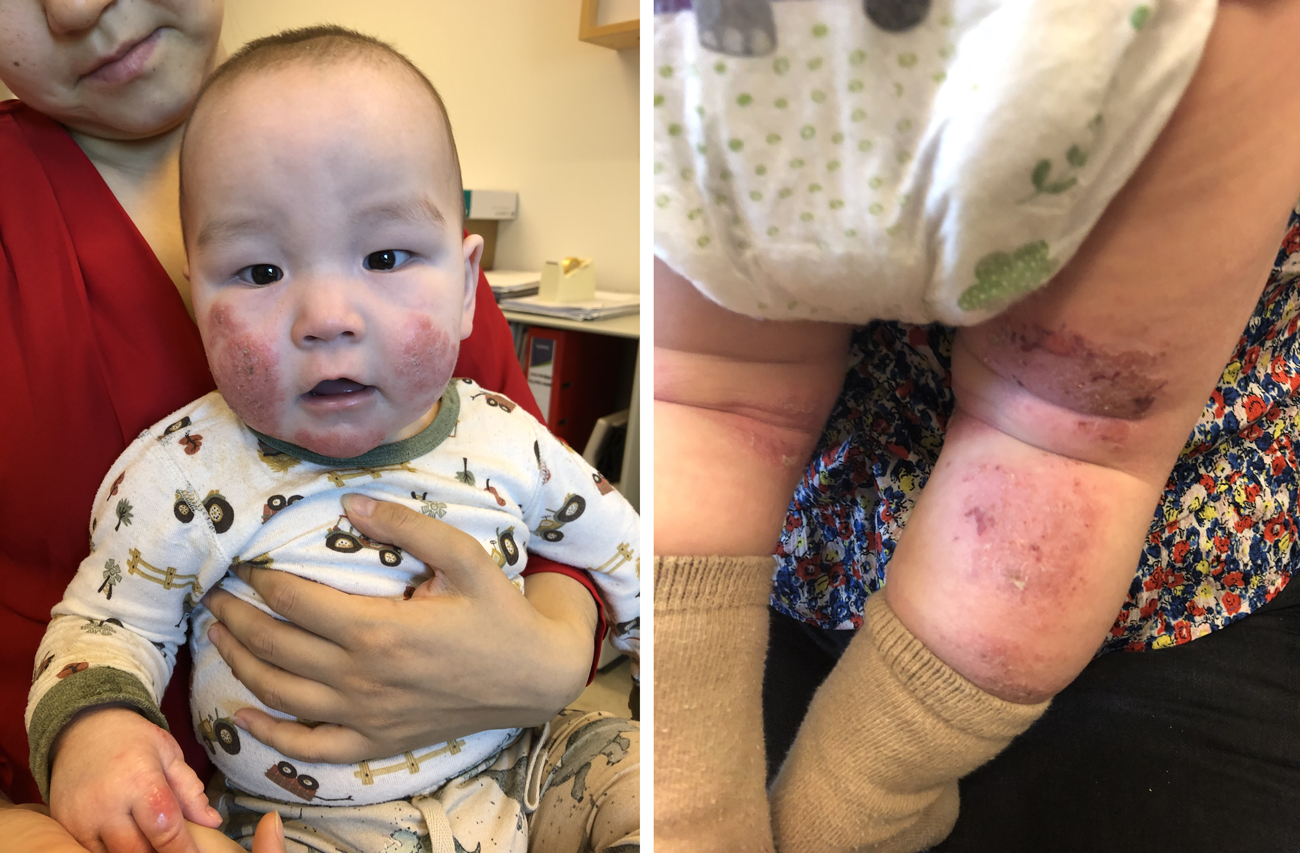For the first time, Ilisimatusarfik, the University of Greenland, has chosen which PhD-projects it needs. The very first project will focus on atopic dermatitis, a condition affecting one in three children in Greenland. Learn more about the project here and get the doctor’s advice on treatment and prevention.

By Sara Kirstine Hald
In Greenland, one in three children aged 0-7 years suffers from atopic dermatitis – also known as “eczema.” In comparison, it affects only one in five children in Denmark. Additionally, the prevalence of severe cases is high in Greenland, and some of the people affected suffer from skin problems their entire lives.
Atopic dermatitis is primarily caused by genetics, and if both parents have suffered from the condition, the chance of their child developing it is up to 80 percent. Studies also suggest that children of Inuit heritage are at an increased risk of developing atopic dermatitis.
Since genetics are a significant factor, there isn’t a straightforward solution to the high incidence of eczema in Greenland. However, you can minimize the discomfort caused by eczema which worsens due to the Arctic climate.
At the bottom of the article, you find a specialized doctor’s seven best tips for treating and eczema and alleviating pain.
Skin is affected by wind and weather
During the cold winter months, people in Greenland often bundle up in layers of clothing, which can affect the skin’s microbiota and ability to regenerate. During winter, the skin is also impacted by the lack of sunlight, and the dry Greenlandic air might also cause the skin to dry out and maybe even crack. When the skin cracks, bacteria can enter minor wounds, exacerbating atopic dermatitis.
“We see very severe cases of atopic dermatitis in Greenland because of issues with wind and weather, which worsen the condition,” says Lone Storgaard Hove, a medical specialist at Dronning Ingrid’s Health Center and the area head of dermatology in Greenland.
She emphasizes that the Greenlandic climate is not the cause of eczema but that cold, dry air and dark winters can exacerbate the condition.

Lone Storgaard Hove is a specialist in general medicine and works, among other things, with skin disorders.
Photo: Private
Keep the skin clean and moisturized
To limit the discomfort of atopic dermatitis, it’s important to keep the skin clean and, for example, change bed linens regularly to avoid bacteria. It’s also essential to keep the skin moisturized. Well-hydrated and well-cared-for skin is much more resilient, reducing the risk of cracks and irritation that increase the likelihood of severe eczema.
Prevention and relief, for the most part, involve basic hygiene and skincare. In many cases, there’s no need for medical products if the child’s skin is properly cared for. Unfortunately, there is a lack of knowledge about atopic dermatitis in large parts of the country.
A new eczema school to open soon
Medical specialists and pediatricians in Nuuk regularly treat atopic dermatitis. However, it can be challenging to disseminate relevant knowledge to healthcare professionals in smaller towns and settlements who may not work regularly with the issue.
“There’s a lot of rotation in healthcare personnel on the coasts, and it’s difficult to spread the knowledge on how to treat eczema to both healthcare professionals and parents in these areas,” says Lone Storgaard Hove.
To make this easier, Dronning Ingrid’s Health Center is launching an eczema school as a pilot project. The school will teach parents, daycare staff, and healthcare professionals throughout Greenland about atopic dermatitis.
The eczema school is not a concept borrowed from another healthcare system but is rooted in Greenland. It will be tailored to local conditions and led by locally based healthcare professionals.
A researcher will evaluate the eczema school
The eczema school needs to be evaluated to ensure that it is as effective as possible.
Therefore, a special PhD job posting was recently published. The posting was based on a concrete Greenlandic challenge. It specifically sought a researcher who would work on atopic dermatitis and contribute to improving the Greenlandic healthcare system by optimizing the eczema school. The deadline for applying was September 1st.
This new approach to offering a PhD-position is different because, traditionally, PhD- projects have been initiated by the researchers themselves. The projects have been based on what might be interesting from a research perspective without necessarily focusing on what healthcare professionals on the ground in Greenland need to know.
The new approach with the evaluation of the eczema school aims to ensure that research is beneficial for Greenland. This is one of the main points in Greenland’s new research strategy.
| What is a PhD? | A PhD is a doctoral education. To complete this education, one must conduct a scientific research project and write a PhD- thesis describing the research and the findings. |
Research on Greenland’s terms
For a long time, health research in Greenland has been conducted by outsiders who may not have an in-depth understanding of Greenland’s conditions and challenges. This has provided healthcare professionals with some important knowledge but not necessarily the most relevant knowledge.
“The questions that form the basis for research are often asked by professionals interested in Greenland but based in Denmark. They ask questions that are interesting from a professional perspective. However, these are not the questions we, as healthcare personnel in the country, ask,” says Gert Mulvad, a doctor at Dronning Ingrid’s Health Center for 35 years.
In addition to being a doctor, Gert Mulvad is the chairman of the advisory board for the Greenland Center for Health Research at Ilisimatusarfik, a member of the Greenlandic Research Council, and chairman of the Scientific Ethics Committee, which assesses all healthcare projects carried out in Greenland. He is one of the initiators of the new approach to Ph.D. projects.
“For many years, there wasn’t many researchers in the country. Most healthcare personnel was employed to improve the general health of the population, but as a larger research capacity is built in the country, new opportunities for health research with a Greenlandic perspective emerge,” says Gert Mulvad.

According to Gert Mulvad, the Greenlandic healthcare system has been quite satisfied with the presence of healthcare researchers from abroad because it has resulted in new knowledge without requiring many resources. However, the time is now right for research to be anchored in Greenland.
Photo: Sara Kirstine Hald
Healthcare professionals will be involved.
The researcher who ends up working on atopic dermatitis will first need to spend time with healthcare personnel in Greenland to understand what they need to know.
“There is probably a significant difference between being in a university environment thinking and experiencing specific challenges and issues in our environment,” says Gert Mulvad.
Instead of working based on researchers’ knowledge and experiences, as has been done before, the project will involve those working with the eczema school and those in contact with citizens. This ensures that the research can be used in practice in the Greenlandic healthcare system.
“There are many conditions in our daily life that are not considered when creating a PhD-project plan at a university in Denmark. With this new PhD-format, the project plan will be developed to meet the needs in Greenland,” says Gert Mulvad.
Several PhD- positions have already been announced based on issues that, like atopic dermatitis, are prominent in Greenland.

Boy from Ilulissat suffering from atopic dermatitis. The child has received treatment at the dermatology clinic in Nuuk where the pictures were taken in October 2023.
How to minimize eczema symptoms
The eczema school may also come to your town, but until then, here are Lone Storgaard Hove’s seven best tips for treating and preventing atopic dermatitis.
1) Keep the child’s skin clean and dry – but moisturized
Make sure to bathe the child and keep the skin clean to minimize the risk of bacterial growth. After bathing, the child should be dried with a towel and moisturized with a rich cream. The skin should be kept clean and dry but moisturized.
2) Avoid perfume and long, hot baths
To avoid irritating the skin, use mild soap and fragrance-free moisturizers on the child’s skin. Avoid long baths and very hot water, as it removes the skin’s natural oils, contributing to dryness.
3) Relieve itching with creams
Atopic dermatitis itches, which understandably annoys the child. By keeping the skin moist with a moisturizing cream, itching is minimized. The less the eczema is scratched, the less the risk of bacterial infections.
4) The innermost layer of clothing should be made of cotton
During winter, we wear many layers of clothing, but it’s important that the skin is able to breathe. Dress your child in natural materials and ensure they’re not too tight. If your child experiences an eczema outbreak, the innermost layer of clothing should be cotton.
Different types of wool are also good choices for clothing but should not be in direct contact with already damaged skin.
5) Avoid smoking tobacco indoor
Tobacco smoke has a worsening effect on atopic dermatitis as it affects damaged skin. Additionally, children suffering from eczema have an increased risk of developing asthma, and tobacco smoke can exacerbate this further.
6) Be consistent with skincare routines
One of the most important things is continuously caring for your child’s skin. If the child has itchy eczema, it might be a struggle to apply cream to the skin, but it’s important to keep at it. Otherwise, the condition may worsen.
Even if you manage to treat an eczema outbreak, you should continue with daily skincare for your child’s skin to prevent new cases of atopic dermatitis. It’s always better to prevent than to treat.
7) Follow healthcare professionals’ recommendations
Eczema can be treated in various ways, including using medical creams. However, this is not always necessary, and the stronger the remedies you use, the higher the risk of side effects. Most importantly, you should always follow healthcare professionals’ guidance to provide the child with the most appropriate treatment.
| Top image: | The image depicts a child with a breakout of atopic dermatitis on their cheeks. The image was created using artificial intelligence with DALL-E 3. Photo: Ole Ellekrog. |